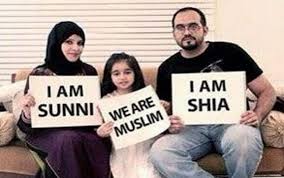When we look at the present world, Islam is the fastest growing religion. According to the Pew Research Centre in 2010, there were 50 Muslim Majority countries in the world, but when we look to these Muslim countries, the position is very outrageous. The rigid sectarian character has created the walls of hate among each other in these countries and had led to attrition in the sense of unity. On the basis of this, hate and inflexible sectarian divide Muslims are unable to unite in one stage. What we see in most of the Muslim majority countries is the aggression between the schools of thoughts; one thought wants to dominate another idea, and under this exercise, they are damaging the future and helping the anti-Muslim forces to achieve their agendas. Muslims, which we see today, are very different and far from the teachings of the Holy Quran and the real teachings of Prophet Muhammad (S.A.W). The real issue among Muslims in the contemporary era is that they are very far away from the teachings of Islam.
Hurdles of the Muslims
Islamic countries are under high strain from the inside as well from outside; the situation we witness among these Islamic countries is so aching. These Muslim countries are passing through numerous hurdles. However, here we examine a few of these:
Dearth of Educational Infrastructure
The first challenge is to accelerate the pace of social, economic, and educational development in their respective nations especially the development of education; recent studies reveal the pathetic picture of Muslim Majority countries.
In 2015, the International Islamic News Agency stated that nearly 37% of the population of the Muslim world is incapable of reading or writing, according to the reports from the Organization of Islamic Cooperation and the Islamic Educational, Scientific and Cultural Organization. In these Muslim-majority countries, illiteracy is a real. Poor literacy rates in the Eastern Middle East countries and a scarcity of educational measures are among the rationales of prominent social chaos.
A 2016 Pew Research Centre on the theme of religion and education around the world noted that Muslims have the small average levels of education following Hindus, with an average of 5.6 years of schooling. Around 36% of all Muslims have no formal schooling; Muslims have also the weakest average levels of higher education of any dominant religious group, with only 8% having graduate and post-graduate degrees.
The most senior of years of schooling among Muslim-majority countries were found in these countries , Uzbekistan (11.5), Kuwait (11.0), and Kazakhstan (10.7). Besides, the average of years of schooling in countries where Muslims are the majority is 6.0 years of schooling, which lags behind the global average (7.7 years of schooling). In the youngest age (25–34) group surveyed, young Muslims have the lowest average levels of education of any dominant religious group, with an average of 6.7 years of schooling, which lags behind the global average (8.6 years of schooling).
Gender and Education
The study also found that Muslims have a significant amount of gender inequality in educational attainment since Muslim women have an average of 4.9 years of schooling; compare to an average of 6.4 years of schooling among Muslim men.
The status of education among the Muslim girls in these countries is so dismal, according to the Islamic Education Scientific and Cultural Organization that there is only 65% illiteracy among Muslim women worldwide. Among the ten countries where poor girls have never gone to school, eight are Muslim majority nations, and half of the Arab women cannot read and write (Amana 2017). It is apparent from the above studies that these Muslim countries are under the dark cloud of self-created internal disasters by their corrupt leadership
Moreover, bad Governance, in these countries, has planted the seeds of instability and uncertainty there. If we look at the Muslim majority countries today, there is the big frustration among new buds against their political systems as the leaders in these countries have adopted the authoritarian model and are infringing the freedom of their subjects. It is this annoyance, which gives birth to what expert called the Arab Spring, or the Arab-awakening movement.
The Tag of Terrorism
The second pessimistic thing that is associated with these Muslim majority countries by some unscrupulous elements and some biased international media is that these countries are encouraging “terrorism”. The repercussions of that this Islamophobia is propagated through the means of the internet and social media. In several countries, Muslim buds are targeted by maintaining the Islamic identity. It was the reason the Triumph administration in America forbade some Muslim majority countries from entering in America.
It is the reasonability of the leadership to show these elements by their character that Islam is not the supporter of extremism, but it supports the welfare of the humanity. However, the predicament is that these Islamic countries are divided into sects that interpret the Islam according to their ideology and school of thought. These schools have constructed the walls in their mind to defend the thought of another school the effect of which severe sectarian hate has taken birth. This might be the real reason why these leaders are unable to defend the negativity diffused in the name of Islam across the world.
Muslims in India
It is the matter worth pondering that the community whose leaders had ruled the country 800 years are now backward in every sphere of life. As we know the present status of the Muslims living in this country that is very worrying. There are few factors are directly or indirectly responsible for the deplorable state of the Muslims in India as the Muslims during the British show stiff resistance to the new ideas of progress that are flowing from west to India especially in the field of education and scientific research. This community spoke against the modernisation of education( even some preachers’ issued the Fatwa against Dr Sir Syed Ahmad Khan). The other communities did not resist the foreign ideas, and they quickly adopted them and moved towards the direction of progress.
The Indian Muslim trouble comes from their own social and cultural rigidity created in the name of religion and sectarian identity (Hamid Ansari 2015). The contemporary position of Indian Muslims can be described broadly under two themes: Powerlessness and the lack of social reform( Omair Anis, 2016).
As per the data of NSSO , 22.3% of Muslims between the ages 17-29 years are illiterate highest among all communities and National average, which is 17%. Among the literate Muslims in the age group, 64 % have secondary, or below secondary education, 9.8% have higher secondary, and 4.1 % have graduate or post-graduate degrees. The education among the Muslim girls shows a bleak picture like 50% of Indian Muslim women cannot read and write (2011 census) the rationale behind poor education among the community the girl child is denied to right education to protect the family honour (Amana 2017).
The Indian Muslim buds should understand the political slogans of power hunger and loving chair politicians before casting a vote and should vote those who are concerning their development. There is a vital need of unity among Muslims who must articulate their voices through democratic means for their safety and security and speak against the discrimination that is going against them at various levels of life.
[The authors, Farooq Ahmad Bakloo & Miss Asma, are Research Scholars at Kumaun University, Uttarakhand, and can be reached at farooqmajeed19@gmail.com]

































